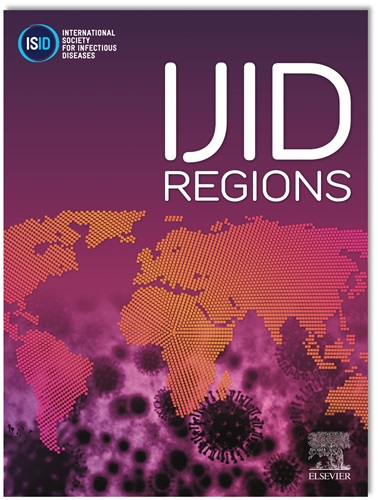新加坡培养确诊肺结核患者的亚临床疾病——一项回顾性研究
IF 4.8
2区 医学
Q1 INFECTIOUS DISEASES
引用次数: 0
摘要
由于缺乏明确的定义和症状,亚临床结核病(TB)的诊断具有挑战性。本研究旨在描述在新加坡(一个发病率中等的国家)常规诊断的文化确诊肺结核患者的亚临床疾病谱,使用不同的定义。它还旨在确定亚临床结核病的危险因素和目前检测亚临床结核病的诊断方法。方法:回顾性分析2004年1月1日至2023年12月31日新加坡国家结核病登记处报告的痰培养阳性肺结核病例。亚临床结核采用了两种定义:定义一为痰培养阳性结核,无咳嗽或咳嗽时间少于两周,定义二为无咳嗽。结果:报告的18693例肺结核病例中,符合亚临床结核病第一定义的占41.6%,符合亚临床结核病第二定义的占31.6%。然而,两种定义在检测亚临床结核病(ROC曲线)方面都表现较好。绝大多数病例(分别为96.7%和96.0%)有胸部x线检查异常,涂片阳性的比例较高(分别为40.0%和35.6%)。痰结核聚合酶链反应(PCR)在检测亚临床结核AOR 1.20方面具有显著意义(95%CI 1.10-31),尽管42.2%无持续咳嗽患者和41.2%无咳嗽患者未进行痰结核聚合酶链反应检测,突出了诊断实践中的差距。总之,老年人(≥70岁)和免疫功能低下的个体,包括终末期肾功能衰竭、类固醇治疗、恶性肿瘤和人类免疫缺陷病毒(HIV)患者更有可能患有亚临床结核病。结论:我们的研究表明,亚临床结核病更可能发生在70岁以上的人群和免疫功能低下的人群中。使用CXR和痰结核聚合酶链反应等诊断方法有助于诊断亚临床结核。有必要进一步研究评估其他筛查工具在检测这些早期疾病状态方面的作用。本文章由计算机程序翻译,如有差异,请以英文原文为准。
Subclinical disease among people with culture-confirmed pulmonary tuberculosis in Singapore - a retrospective study
Objectives
Subclinical tuberculosis (TB) is challenging to diagnose due to the lack of a clear definition and symptoms. This study aimed to describe the subclinical disease spectrum among people with culture-confirmed pulmonary TB routinely diagnosed in Singapore, a country with moderate incidence, using different definitions. It also aimed to identify risk factors for subclinical TB and the current diagnostic approaches in detecting subclinical TB.
Methods
A retrospective analysis of sputum culture-positive pulmonary TB cases reported to the Singapore National TB Registry from January 1, 2004 to December 31, 2023 was conducted. Two definitions for subclinical TB were used: sputum culture-positive TB with no cough or cough for less than 2 weeks for definition 1 and no cough for definition 2.
Results
Of 18,693 pulmonary TB cases notified, 41.6% and 31.6% met the first and second definition of subclinical TB, respectively. However, neither definition performed better in detecting subclinical TB (receiver operating characteristics curve). The majority of cases (96.7% and 96.0% respectively) had abnormal chest X-ray findings, and a high proportion had smear-positive results (40.0% and 35.6%, respectively). Sputum TB polymerase chain reaction (PCR) was significant in picking up subclinical TB adjusted odds ratio 1.20 (95% confidence interval 1.10-31), although 42.2% with no persistent cough and 41.2% with no cough did not have sputum TB PCR tested, highlighting gaps in diagnostic practices. Together, older adults (aged ≥70 years) and immunocompromised individuals, including those with end-stage renal failure, steroid therapy, malignancy, and HIV, were more likely to have subclinical TB.
Conclusions
Our study suggests that subclinical TB are more likely to occur in those older than 70 years and those with immunocompromising conditions. The use of diagnostics such as chest X-ray and sputum TB PCR are helpful in diagnosing subclinical TB. Further research is necessary to evaluate other screening tools in detecting these early disease states.
求助全文
通过发布文献求助,成功后即可免费获取论文全文。
去求助
来源期刊
CiteScore
18.90
自引率
2.40%
发文量
1020
审稿时长
30 days
期刊介绍:
International Journal of Infectious Diseases (IJID)
Publisher: International Society for Infectious Diseases
Publication Frequency: Monthly
Type: Peer-reviewed, Open Access
Scope:
Publishes original clinical and laboratory-based research.
Reports clinical trials, reviews, and some case reports.
Focuses on epidemiology, clinical diagnosis, treatment, and control of infectious diseases.
Emphasizes diseases common in under-resourced countries.

 求助内容:
求助内容: 应助结果提醒方式:
应助结果提醒方式:


